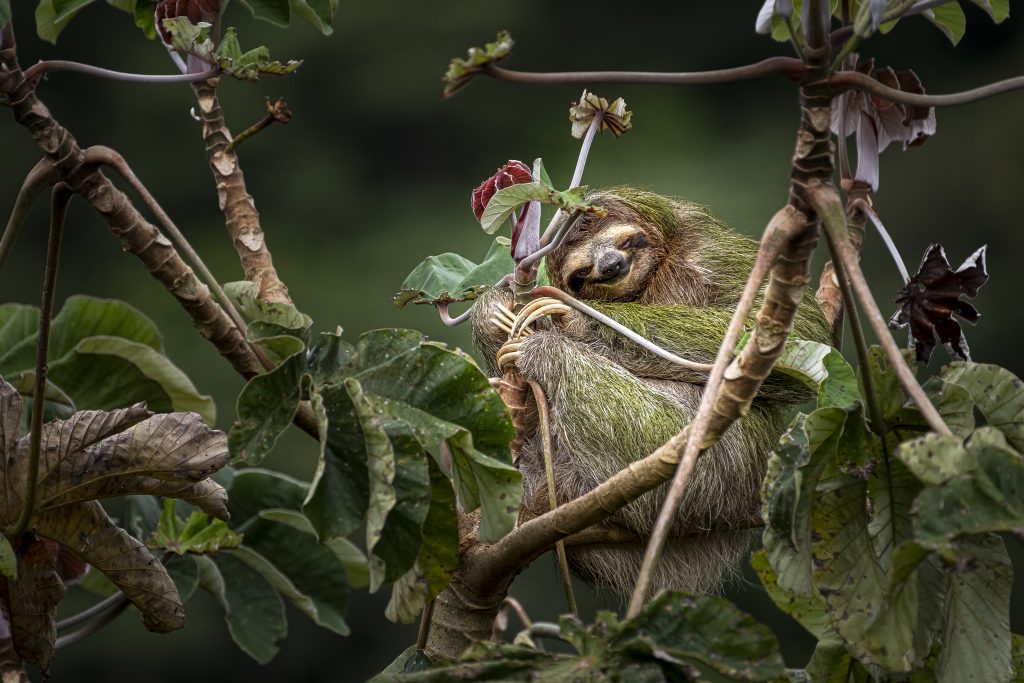The brown-throated three-toed sloth (Bradypus variegatus) is an interesting and unique creature that lives in Central and South America. Found in tropical rainforests, these sloths are known for their slow movement and distinctive appearance. With a shaggy coat of long fur, the brown-throated three-toed sloth has three long claws on each limb and a small tail.

Appearance: Fur & Coloring
The brown-throated three-toed sloth is a species of sloth found in Central and South America that has an unusual appearance. It is typically characterized by its dark brown fur and distinct coloring. With its striking pattern of white stripes on its head, back, and arms, the brown-throated three-toed sloth makes for an interesting sight in the jungle canopy. Its coat can range from light to dark brown depending on the time of year, with white fur scattered throughout the body. The face is usually covered with white hair which can give this species a unique look compared to other types of sloths.
The dense coat of fur helps protect this animal from predators while it sleeps during the day and comes out to feed at night. Additionally, it helps insulate them against extreme temperatures or rains that may occur in their natural environment. The shaggy coat has grooved hair that is host to symbiotic green algae which camouflage the animal in the trees and provide it nutrients. The algae also nourish sloth moths, some species of which exist solely on sloths.
Diet: Favorite Foods
When it comes to diet, the brown-throated three-toed sloth has a clear favorite: leaves. This small mammal, found in regions of Central and South America, feeds on leaves from several species of trees such as cecropia and figs. In fact, studies have shown that 97% of their total diet consists of these leaves. They are incredibly adapted to conserve energy by eating low-nutritional food items like these.
Sloths also eat fruits and flowers occasionally if they come across them while foraging for leaves but the bulk of their nutrition comes from their staple food source which is a variety of different tree foliage. The unique digestive system of the sloth allows them to take full advantage out of the low nutritional value leaves provide by fermenting the cellulose in their stomach over an extended period until it is fully digested.
Habitat: Where They Live
Brown throated 3 toed sloths are found from Honduras in the north, through Nicaragua, Costa Rica and Panama into Venezuela, Colombia, Ecuador, Bolivia, Brazil and eastern Peru. They areone of the most unique and slowest animals in the world. Found mainly in South American rainforests, they have incredibly adapted to their environment by becoming a master of camouflage. Their brown fur adapts to different shades based on how much light is present; helping them blend seamlessly into the trees they call home.
Sloths are known for their arboreal lifestyle which means that they spend nearly all their time in the trees, rarely coming down except when necessary. This helps them escape predators and keep a safe distance from any potential danger. The leaves and branches of these trees provide ample nutrition and refuge for these animals as well as allowing them to move around easily without fear or being spotted by other animals.
Reproduction & Lifespan
The mating season for the Brown-throated Three-toed Sloth begins in April, where males gather together in large groups called “affiliations” in order to compete for females. After mating, a female will give birth to one young after 11 months of gestation. The youngster clings tightly to its mother until it is eight months old, when it begins learning how to climb and feed. On average, the Brown-throated Three-toed Sloth can live up to 20 years with proper care and nutrition.
Conservation Efforts
Conclusion: Protecting Sloths
The brown throated 3-toed sloth is a unique and fascinating species native to the rainforests of Central and South America. As with many endangered species, its population has been on the decline due to habitat destruction, fragmentation, and poaching. To ensure that these creatures continue to thrive in their natural environment, we must take action now to protect them.
Protecting sloths requires an integrated approach that includes conserving key habitats, strengthening laws against poaching and illegal trade, promoting education and research initiatives on sloth conservation, and incentivizing sustainable forest management practices. For instance, protected areas are needed for the survival of critical habitats such as mangroves or lowland forests which provide essential resources for sloths. Additionally, strict enforcement of anti-poaching laws should be implemented along with educational campaigns to raise awareness about the importance of conserving this species.
Please bookmark us now press ctrl+d and visit again soon for more fascinating nature images! A selection of Nature images, wildlife, flora and landscape stock photos, to see many more images and to license our stock photos please see our complete collection of our wildlife, flora and landscape stock images here at Alamy.
Introducing our captivating photo book showcasing the mesmerizing flora and fauna of Panama! Dive into the vibrant world of biodiversity with stunning imagery capturing the essence of Panama’s natural wonders. From majestic birds to elusive wildlife and breathtaking landscapes, this book is a visual feast for nature enthusiasts. Don’t miss your chance to own a piece of Panama’s natural heritage. Order your copy here at Amazon now and embark on a visual journey through the enchanting landscapes and fascinating wildlife of Panama!